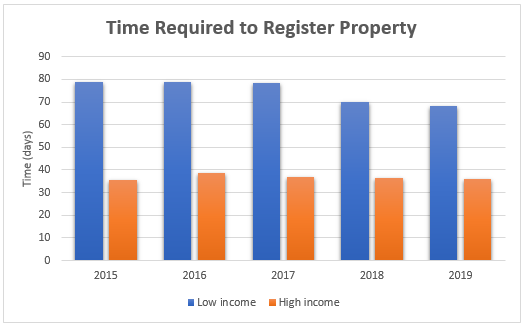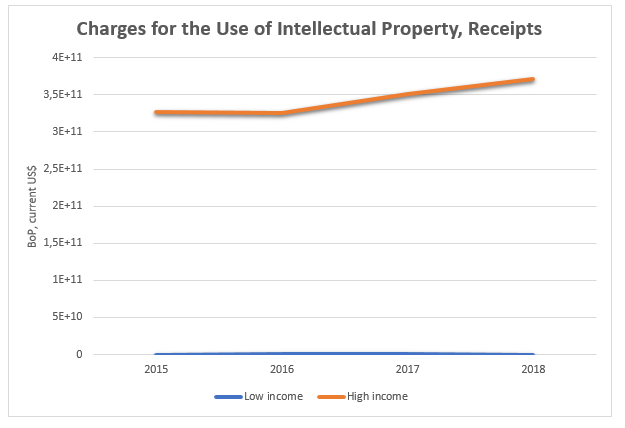Introduction
Intellectual property rights refer to the entitlements given to individuals over the inventions of their minds. They provide the originator with full rights over the use of their innovation for a specified period. They also allow creators to benefit from their innovations. The safeguarding of intellectual property rights is a valuable engine for economic growth in a country (Peng, Ahlstrom, Carraher, & Shi, 2017). The purpose of this paper is to report and compare variables related to intellectual property rights between high and low-income countries.
Findings
There were notable differences in several variables related to intellectual property rights between high-income and low-income countries. Figure 1 shows that the average time required to register intellectual property is longer in low-income countries than in high-income nations. Trend analysis over the last five years shows that it requires between 70 and 80 days for an individual to register intellectual property.
Conversely, high-income countries require between 30 and 40 days to register intellectual property (The World Bank, 2020). This observation could be attributed to an enabling environment that eliminates obstacles in the registration process in high-income countries. Developed countries publish unexamined patent applications, which lessens the overall time required to register intellectual property rights (Zhang, Yu, Feng, Liu, & Yang, 2017).

Figure 2 shows the number of steps required to register intellectual property in high and low-income countries. There is a slight difference in this variable. High-income countries require an average of 5.2 steps to register intellectual property, whereas low-income countries need at least 6 steps for the complete registration of property (The World Bank, 2020). The registration of intellectual property has five general steps of maintaining the secrecy of trade ideas, documentation of concepts, applying for a trademark, registering the intellectual properties, and finally making the investment. Details regarding these steps may vary slightly, for instance, the examination of patents before publishing. High-income countries consider this step, which is overlooked in low-income countries hence increasing the total number of steps required to 6.

Figure 3 shows the differences in charges incurred to use intellectual property in high and low-income countries. There was a big difference between these charges with high-income countries charging at least 350 billion US dollars for the use of intellectual property. On the contrary, low-income countries charged only between 71 million dollars and 2.63 billion dollars to use intellectual property.

This observation could be linked to the fact that high-income countries have more disposable income thus spend more money to promote creative works while at the same time incentivizing research and development. As a result, there is more creativity and economic growth, which motivates industries to invest more in the acquisition of technology from their developers. According to the Commission on Intellectual Property Rights, the costs and benefits of intellectual property rights differ across various economies (Sherwood, 2019). Developing countries are more likely to bear disproportionately higher costs than benefits, particularly because intellectual property rights offer more privileges to producers than consumers.
Conclusion
Protecting the intellectual property rights of creations inspires innovation, which in turn spurs economic growth. Overall, high-income countries have measures in place to encourage and safeguard innovations. These measures are inadequate in low-income countries and can be linked to low innovations in these countries.
References
Peng, M. W., Ahlstrom, D., Carraher, S. M., & Shi, W. S. (2017). History and the debate over intellectual property. Management and Organization Review, 13(1), 15-38.
Sherwood, R. M. (2019). Intellectual property and economic development. Abingdon, United Kingdom: Routledge.
The World Bank. (2020). World development indicators. Web.
Zhang, G., Yu, G., Feng, Y., Liu, L., & Yang, Z. (2017). Improving the publication delay model to characterize the patent granting process. Scientometrics, 111(2), 621-637.